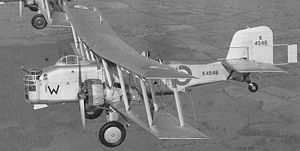| Overstrand | |
|---|---|
 Overstrand in flight | |
| General information | |
| Type | Bomber |
| Manufacturer | Boulton Paul |
| Designer | H.A. Hughes |
| Primary user | Royal Air Force |
| Number built | 28 (four converted Sidestrands) |
| History | |
| Introduction date | 1934 |
| First flight | 1933 |
| Retired | 1941 |
| Developed from | Boulton Paul Sidestrand |
The Boulton Paul P.75 Overstrand was a twin-engine biplane medium bomber designed and produced by the British aircraft manufacturer Boulton Paul. It was the final example of a series of biplane medium bombers that had served in the Royal Air Force since the First World War, starting with the likes of the Vickers Vimy and Handley Page Type O. The Overstrand was also the first aircraft to be fitted with a fully-enclosed power-operated turret.[1]
First flown in 1933, the Overstrand was essentially an improved model of the Boulton Paul Sidestrand of the 1920s, thus early references to the type referred to it as the Sidestrand Mk IV instead. It demonstrated a higher maximum speed than its predecessor and was procured for the RAF in limited numbers. As such, the type entered service during the mid 1930s, but became increasingly overshadowed by the new generation of monoplane medium bombers, such as the Vickers Wellington and Armstrong Whitworth Whitley. Nevertheless, the Overstrand remained operational during the early years of the Second World War, albeit only being flown by training units. The few surviving aircraft were withdrawn from service during 1941, having been rendered surplus to requirements.